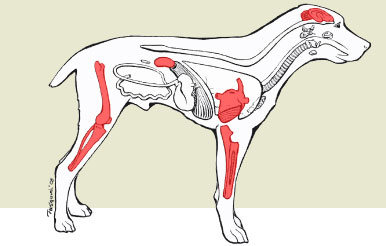Tails
Making pet parenting easy

Lyme disease in dogs
This entry was posted on 2014-07-01.
Lyme disease is transmitted by tick bite caused by a spirochete (bacteria) species of the Borrelia burgdorferi group. In dogs, it commonly results in inflammation of the joints and may also include more serious complications such as damage to the kidney and rarely heart or brain. Kidney disease appears to be more prevalent in Labrador retrievers, golden retrievers, and Bernese Mountain dogs.
Symptom and Types
The most common symptom found in Lyme’s disease is lameness of the limbs due to the involvement of the joints. This however may present in different ways. The lameness may be recurrent or may occur more suddenly, which lasts for only three to four days but may recur days to weeks later in the same leg or in other legs. This has been referred to as “shifting-leg lameness”, lameness in one leg, with a return to normal function followed by involvement of another leg. The joints are usually swollen and warm to the touch and a pain response may be elicited by feeling the joint.
If the kidneys are involved, it may lead to total kidney failure which may be demonstrated with signs of vomiting, diarrhoea, lack of appetite, weight loss, increased urination and thrist.
Causes
The bacteria Borrelia burgdorferi is responsible for Lyme disease and is transmitted by herd-shelled deer ticks. The infection typically occurs after the Borrelia-carrying tick has been attached to the dog for at least 18 hours.
Treatment
Lyme disease is treated with antibiotics over a four week period and mostly done as an outpatient unless your dog’s health condition is severe.
Unfortunately, symptoms do not always completely resolve and your dog may suffer from long-term joint pain even after the bacteria has been cleared from your dog’s system.
Prevention
Prevention lies in avoiding tick bites and therefore preventing your dog from roaming in tick-infested environments where Lyme borreliosis is common as much as possible. Grooming your dog daily and removing ticks by hand can also be accompanied with a variety of sprays, collars and topical products to repel ticks as recommended by your veterinarian.
Living and Management
The inflammation of the joints should start to improve within three to five days of antibiotic treatment. If there is little to no improvement after the initial five days, your veterinarian will want to reconsider the diagnosis.


